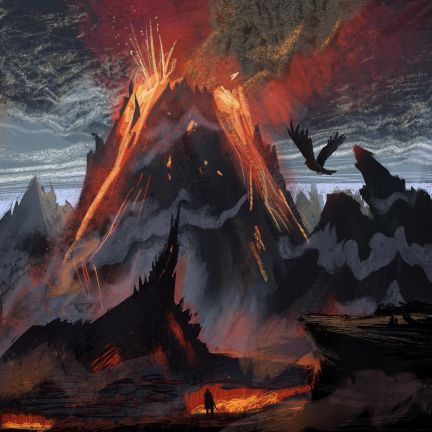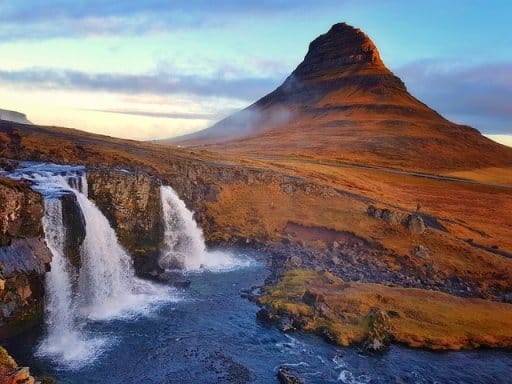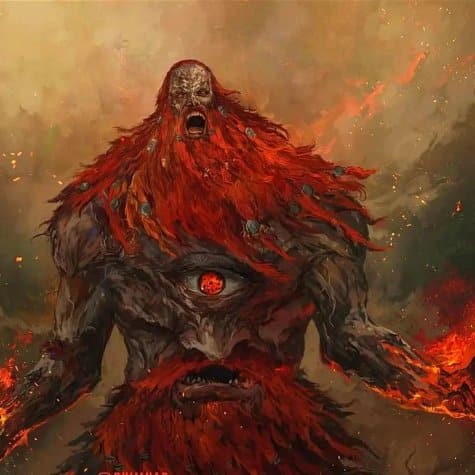Old Norse myths are filled with fascinating stories, complex characters, and rich symbolism. All the stories of gods, giants and heroes take place in the nine realms. Before the creation of the nine realms though, there were only two elemental realms.
Muspelheim’s role in this creation myth is of paramount importance, as it serves as one of the primordial realms that gave birth to the cosmos. As a realm of fire and heat, Muspelheim’s interaction with the icy world of Niflheim sets the stage for the formation of life and the world as we know it.
Throughout history, various cultures have developed unique interpretations of the cosmos. Norse mythology has always stood out to me because of its intricate stories and intriguing characters. Through our exploration of Muspelheim, we will delve deeper into the realm’s significance and its inhabitants, unraveling the mysteries that this fiery world holds.
Origins and Etymology of Muspelheim

The fire realm Muspelheim (Old Norse: Múspellsheimr) was also called Muspell (Old Norse: Múspell). Muspelheim’s etymology is debated, but one possibility suggests it comes from Old Norse “mund-spilli,” which could be a combination of Latin “mundus” (world) and Proto-Germanic *spilþijaną (to kill, ruin, murder), together meaning “destruction of the world.” It has cognates in Old Saxon mūdspelli and Old High German muspilli.
Following that reasoning, then Muspel, or Muspellr would be the “Destroyer of the World ” and Muspel+heim would be his home. This does indeed align with other evidence we have. In Old Norse, Muspellr appears as a proper name, possibly representing the progenitor of a group of fighters, known as ‘Muspellr’s sons.’ These fighters, led by the fiery Surt, it is said will march out of Muspelheim to battle against the gods during Ragnarök.
The term Muspellr can be found in both the Poetic Edda’s Völuspá and Loki’s poem Lokasenna, while the Prose Edda provides more details about Muspelheim and its inhabitants. The realm’s name then obviously reflects its fiery nature and world-destroying potential. Understanding its role in Norse mythology provides great insight into the duality of so many aspects found in Norse mythology.
Description of Muspelheim
Muspelheim is a realm defined by fire, lava, and volcanic landscapes. Its extreme temperatures make it a unique, inhospitable world. Yet, it’s crucial to Norse cosmology as it facilitates both the beginning and the end of the nine worlds. This realm shares boundaries with other worlds, and its essence of fire holds a deeper symbolism in the Norse myths, representing forces of destruction and change.
Some notable features of Muspelheim include:
Vast seas of molten lava
Towering volcanoes
Flaming rivers
Ashen plains
These environmental characteristics have shaped the lives of the inhabitants of Muspelheim, molding them into powerful beings capable of withstanding extreme conditions.
Muspelheim and Iceland: A Viking Perspective
Reading about Muspelheim, it’s hard not to think about Iceland and how the volcanic island must have impressed the Vikings. The Vikings’ discovery of Iceland likely resonated with their beliefs in Norse mythology, particularly the similarities between Iceland’s volcanic landscapes and Muspelheim’s fiery realm.

Fiery Landscapes
Muspelheim and Iceland both feature volcanic landscapes and extreme temperatures. The Vikings may have been struck by the resemblance between Iceland’s volcanoes, geysers, and hot springs and Muspelheim’s mythological descriptions.
Destruction and Transformation
The Vikings could have linked Muspelheim’s destructive power, as seen in Surtr’s role in Ragnarök, with Iceland’s geological hazards. Both realms share the potential for volcanic eruptions, earthquakes, and the transformative power that reshapes the land.
Balance of Opposites
In Norse mythology, fire (Muspelheim) and ice (Niflheim) create the world. This balance is also present in Iceland’s landscape, with its volcanic activity and contrasting glaciers and ice caves. The Vikings might have recognized this connection between their mythology and Iceland’s contrasting elements.
Their discovery of Iceland may have evoked images of Muspelheim, highlighting similarities in volcanic landscapes and themes of destruction, transformation, and balance. Comparing the realm of Muspelheim with that of Iceland I believe potentially offers insight into the Vikings’ worldview. It also ties in with how mythology often shaped their understanding of natural phenomena.
Muspelheim in Norse Mythology
The Norse creation myth begins with Ginnungagap, a vast, primordial void. On one side of this void lies Muspelheim, the realm of fire, heat, and destruction. On the opposite side is Niflheim, the realm of ice, cold, and darkness. The two realms represent polar opposites, with Muspelheim embodying the fiery, transformative aspect of existence, while Niflheim encompasses the cold, preserving nature.
Life starts in a primordial pool
As the elemental forces of Muspelheim and Niflheim interacted within the void, their meeting led to the birth of the first living being in Norse mythology – the great frost giant, Ymir. The heat from Muspelheim’s fires caused the ice of Niflheim to melt, forming a primordial pool. From this mixture of fire and ice, Ymir emerged, a being of immense size and power. Ymir is considered the ancestor of all the jötun frost-giants, a race of beings closely linked to the origins of the cosmos.
Muspelheim’s role in the Norse creation myth is fundamental, as it symbolizes the transformative and creative aspects of fire. The interaction between Muspelheim and Niflheim sets the stage for life, demonstrating the importance of balance and harmony between opposing forces. This theme is prevalent throughout Norse mythology, reminding us that the natural world and the cosmos are intricately connected, with each force playing a vital role in shaping the existence we experience.
Worlds burning in the end
Like so many things in Norse mythology, the creation of the worlds is part of a cycle, to be repeated. For that to happen, all things must first burn. The ultimate destruction in Ragnarök will be led by the Fire-giant Surt, leading Muspellr’s sons marching out of Muspelheim. In this cataclysmic event, the forces of Muspelheim will clash with the gods and their allies.
Muspelheim’s role in the Norse creation myth is fundamental, as it symbolizes the transformative and creative aspects of fire. Like the first interaction between Muspelheim and Niflheim set the stage for life, burning it all again sets the stage for a new beginning. Bringing forth a new world born from the ashes of the old.
The involvement of Muspelheim and its inhabitants in Ragnarök highlights the realm’s significance in shaping the destiny of the cosmos.
Inhabitants of Muspelheim
Other than being central in the cycle of creation and destruction of the worlds, we know little about Muspelheim. Nothing is said about where the Fire-giants come from, but I think it’s likely they are jotnar. Where Jotunheim is often described as mountainous, cold and icy, Muspelheim is the opposite. Possibly there are tales, now long lost, that explain how some of the jotnar came to live in both realms.
Whereas there are many tales of Thor or other gods venturing into Jotunheim, there are no such adventures in Muspelheim. Possibly it was simply too inhospitable to survive even for them, a primordial realm of pure destruction.
However, there are four mentions of Fire-giants or jotnar that likely, or definitely comes from the realm of fire.
The Fire-giants

First, Surt (Old Norse Surtr) is the leader of the Fire-giants and possibly the ruler of Muspelheim. Unless there is some more shadowy entity called Muspel (Old Norse Muspellr), Surt is the ruler.
Secondly, as it is prophesied when Ragnarök happens, Surt will lead “The sons of Muspel”. They will be breaking the Bifrost bridge as they ride across it to the plain of Vigrid for the final battle. As such, there must be a large number of Fire-giants living with Surt in Muspelheim.
Thirdly, there is a mention of a jötun that seems to have all the characteristics of a Fire-giant. That is if they are indeed a separate type of jotnar. In the story of Utgard-Loki, retold in Gylfaginning, Thor travels to Jotunheim together with the mischiveous Loki. Being challenged to different contests, Loki is to have an eating contest with a jötun called Logi.
Logi not only eats all the food faster than Loki, he also consumes the bones and the very trough they were eating from. It is later revealed in the story that Logi is the personification of wildfire.
The family of Logi the Fire-giant
Finally, Logi is never mentioned in the Eddas, however, he is attested to in two other sagas found only in the Icelandic Flateyjarbók. There we also learn he has a family of fire-related jotnar.
- In the How Norway was inhabited (Old Norse: Hversu Noregr byggðist) we learn that Logi is in fact brother of Aegir, the ruler of the oceans. Logi is said to rule fire (no surprise there)
- The other mention is in The Saga of Thorstein, Viking’s Son (Old Norse: Þorsteins saga Víkingssonar). There he also goes by the name Hálogi and we learn he has a wife named Glod (Old Norse: Glöð). Together they have two daughters, Eisa (“glowing embers”) and Eimyrja (“embers”). Seemingly they are most definitely all closely associated with fire.
Last Thoughts on Muspelheim
Muspelheim, the realm of fire and heat, plays a significant role in Norse mythology. Its depiction as a land filled with lava flows, fiery rivers, and towering volcanoes embodies the transformative power of fire. Muspelheim’s importance is evident in its involvement in the creation myth, where its fire and heat meet the icy realm of Niflheim, giving birth to the world. Furthermore, the realm’s destructive potential is highlighted by Surt, the fire giant who leads his forces during Ragnarök, the cataclysmic event that marks the end of the world.
Muspelheim serves as a reminder of the ever-present duality in Norse mythology, reflecting the balance between opposing forces that shape the universe. It also illustrates the Vikings’ perception of the world and their understanding of natural phenomena through the lens of their beliefs. Muspelheim’s lasting impact on the collective imagination ensures its place in the rich tapestry of Norse mythology.
FAQs
Muspelheim is one of the Nine Worlds and the realm of fire in Norse mythology. It plays a vital role in the creation myth and in Ragnarök, where its destructive power is unleashed by Surtr and his fire giants.
Surtr is a fire giant and the ruler of Muspelheim. During Ragnarök, he leads his forces against the gods, wields a flaming sword, and sets the world ablaze, ultimately contributing to its destruction.
In the creation myth, Muspelheim’s fire and heat meet the cold and ice of Niflheim, resulting in the formation of the world. The interaction between these two realms signifies the balance of opposites that shapes the universe.
Muspelheim embodies the destructive and transformative power of fire, as seen in its volcanic landscapes and Surtr’s role during Ragnarök. The realm’s destructive potential also reflects the ever-changing nature of the world in Norse mythology.
Surtr is the most prominent fire giant in Muspelheim, and Norse mythology primarily focuses on him. Although the ancient texts do not provide an extensive list of other named fire giants in Muspelheim, they do mention other giants, like Logi, who embody aspects of fire but are not explicitly linked to the realm.
Featured Image Credit: marjoramarts via Instagram
